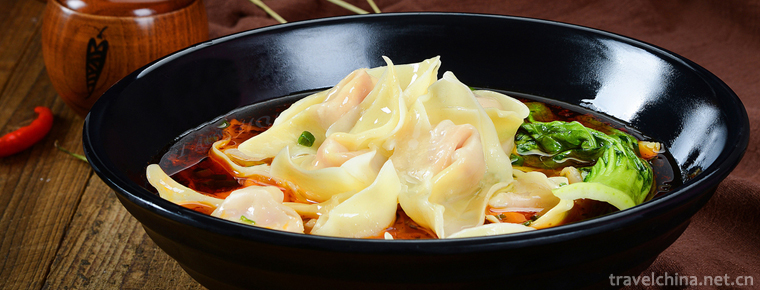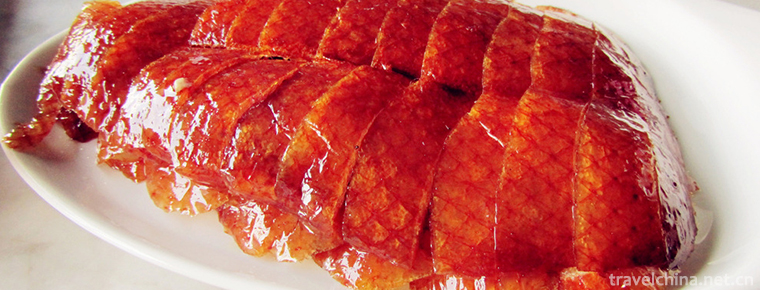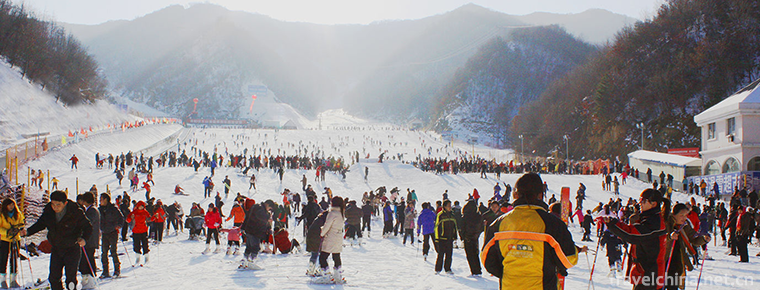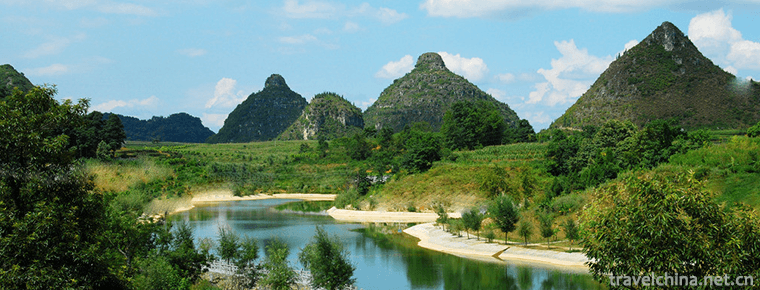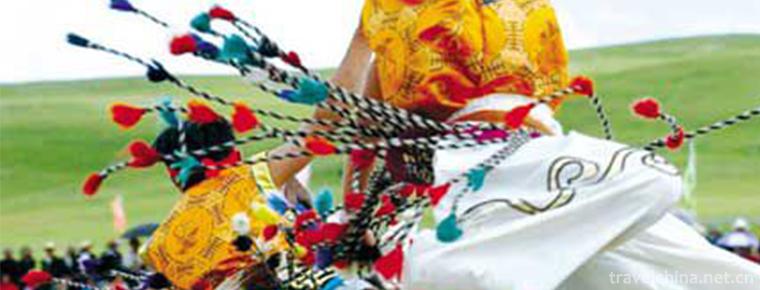Thousand Buddhas Mountain
Qianfo Mountain is one of the three major scenic spots in Jinan. It was called Lishan in ancient times. Because it was called Shun's farming in Lishan in ancient times, it was also named Shun Mountain and Shun's farming mountain. During the Sui Kaihuang period (581-600 years), thousands of Buddha statues were carved along the mountain trend because of the prevalence of Buddhism, so it was called Qianfo Mountain.
Qianfo Mountain is the remnant of Mount Taishan, 285 meters above sea level, covering an area of 166.1 hectares, 2.5 kilometers away from the center of Jinan City, located in the south of Jinan City, Shandong Province. It is also known as the three major scenic spots of Jinan with Baotu Spring and Daming Lake. It is the national AAAA-level scenic spot and the ninth batch of national scenic spots.
On September 5, 2016, Qianfo Mountain Cliff Stone Statues and Stele Inscriptions are listed as cultural relics protection units in Shandong Province.
Historical records
Qianfo Mountain was called Lishan in ancient times. It is said that when Emperor Yushun was a people, he had plowed under the Lishan Mountain, so it was also named Shun Mountain or Shun Tingshan.
According to historical records: during the Sui Dynasty, Buddhism prevailed in Shandong Province. Devoted believers engraved a large number of stone Buddhas along the walls of the mountain, and built the Temple of Thousand Buddhas and got the name of Thousand Buddhas Mountain. Along Pandao West Road, there is a Tang Huai Pavilion and an ancient Huai tree beside the pavilion. It is said that Qin Qiong, a famous general of the Tang Dynasty, was tied here. Halfway up the hill there is a painted archway, namely "Qiyan Nine Points" archway. Boarding the pavilion, looking north from the fence, Daming Lake is like a mirror near, the Yellow River is like a belt in the distance, and the scenery of Quancheng is at a glance.
The stone Buddha carvings on Qianfo Mountain are concentrated on the Qianfo Cliff behind Xingguo Temple. Xingguo Temple, also known as Qianfoshan Temple, was built in the Tang Dynasty, and has been built in many generations. On the cliff above the southwest of the temple gate are inscribed four seal characters of "First Meihua", each of which is about 4 meters square. There are more than 60 stone Buddhas in the Sui Dynasty on the Qianfo Cliff, which has a long history and high artistic value. To the east of Qianfo Mountain, there are also stone Buddhas carved on Fohui Mountain. At the foot of the main peak there is a Buddha niche with a head Buddha statue, which is 7 meters high and 4 meters wide. It is commonly known as the "Big Buddha Head", which is a very rare stone carving. Qianfo Mountain is the remnant of Mount Tai. It covers an area of 166.1 hectares at 285 meters above sea level and is 2.5 kilometers away from the city center.
Main attractions
Myriad Buddha Hole
Located at the northern foot of Qianfo Mountain, Wanfo Cave is a great scenic spot of Qianfo Mountain. It was built in 1992. It integrates the essence of the four national grottoes of Dunhuang, Longmen, Maijishan and Yungang. Through artists'selection, concentration, reconstruction and imitation, nearly 30,000 Buddhas, Bodhisattvas, disciples and Kings of Heaven were created, with a maximum length of 28 meters, a 15-meter-high Buddha standing in front of the cave, and more than 10,000 square meters of murals in the cave. Each of them has its own beautiful, magnificent, implicit, beautiful, magnificent and rugged style, reflecting the artistic charm of Chinese cave sculptures. Exploring past civilizations opens the door to history. The Wanfo Cave consists of four parts: Mogao Collection, Longmen Essence, Maiji Miracle and Yungang Gathering. The length of the cave is 500 meters, which records the changes of the development history of Chinese Buddhism and contains profound cultural connotations.
Buddhist art spread to China from the Eastern Han Dynasty. Through long-term speculation and absorption of the essence of the working people, a special style with the spirit of the Chinese nation has been formed. These characteristics are fully embodied here. Here we can look at the statues of the Northern Wei, Tang and Song dynasties. It can be said that "a Museum of grotto art with thousands of painted sculptures and murals is a museum of grotto art with thousands of miles in sight". Former NPC Chairman Wanli, Vice Premier Gu Mu of the State Council and other leaders have visited here.
Thousand-Buddha Cliffside Sculptures
In the south side of Xingguo Zen Temple, it is the earliest statue group in Jinan City. It is valuable to study Buddhism in Sui Dynasty.
On the cliff, there are nine caves with more than 130 Buddhist statues carved in the seven years (587) to fifteen years (595) of Kaihuang in the Sui Dynasty. Paradise Cave is the main cave in the statue group. Amitabha Buddha sits cross-kneed in the middle. It is 3 meters high and decorated with Buddhist light behind. On the right, the Bodhisattva arrives at the general situation. On the left, the Guan Shiyin Bodhisattva stands at a height of nearly 3 meters. It was chiseled in the eleventh year of Kaihuang (591). The other caves are scattered on the stone walls outside the cave.
The cliff statues and stele inscriptions of Qianfo Mountain are located in the scenic spot of Qianfo Mountain. They include the cliff statues of Qianfo Mountain, Kaiyuan Temple, Dafotou Cliff and Huangshiya Cliff.
It is composed of Huangshiya cliff statue, Qianfoshan Xingguo Chan Temple cliff statue, Qianfoshan Kaiyuan Temple cliff statue, Dafotou Cliff statue, Qing Qianlong "Qianfoshan Extreme Eyesight Works" stele and Qing Dynasty "Qianfoshan Cutting Tree Special Show", Qing Qianlong Lishan stele, Qing Guangxu Dingbaozhen Twelve Screen Stele inscription and so on. The ages are Northern Wei Dynasty, Sui and Tang Dynasty, Song Dynasty and Qing Dynasty respectively.
According to the relevant person in charge of Jinan City Landscape and Greening Bureau, the four scenic spots declared for provincial cultural relics were previously Municipal Cultural relics. In 2015, they were recommended by the Municipal Cultural Relics Bureau to declare the fifth batch of provincial cultural relics protection units. Eventually, Qianfo Mountain cliff statues and stele inscriptions were approved because of their important historical, artistic and scientific values and better protection. "At first, it was declared separately as the four scenic spots, and the final approval of the Provincial Bureau of Cultural Relics was approved as a packaged scenic spot."
The cliff statues and stele inscriptions of Qianfo Mountain are located in Qianfo Mountain and Fohui Mountain. Many statues are located on the top of 350 meters above sea level. In recent years, the city's gardening departments have beautified and upgraded the surrounding environment of cultural relics. For example, under the statue of Yellowstone Cliff, an ornamental trestle road was built, which not only facilitated the viewing of tourists, but also avoided the destruction of the statue caused by human touch and other acts.
Guanyin Garden
Inside the Guanyin Garden, there are steep rocks on the Bank of the pond, rocky sleeping waves and beautiful stone decorations. Birds sing in the shade. The water in the pool is clear, the lotus blossoms are bright, and the golden carp play. Built-in fountain, splashing beads to release jade, rainbow reflecting the sun, is a spectacle. Standing in the lotus pond is "Baiyi Guanyin" up to 13 meters, the largest of the Guanyin Garden. There are also all kinds of Guanyin in disguised form around the pool, which is elegant and lifelike.
Guizhou Loudong
In the east of Jile Tung. Deep several meters, three folds later is rectangular, for artificial digging, similar to the room, an area of 20 square meters, two meters high, the original sitting image in the middle.
In the upper part of the cave, there are stone carvings on one side. The big character is "Qianlou Cave". Small characters record the life of Qian Louzi, which means: Qian Louzi, the people of Qi in Zhou Dynasty, cultivate their integrity, do not care about princes, live in seclusion here, dig a stone cave, never go to the mountains for life, have written four books, the name of Qian Louzi, all talk about Taoist things, Lu Gong Gong heard that he had talent, sent envoys to hire him as prime minister, and was rejected by him. Whenever King Qiwei was defeated, he came to consult him, and Lou Zi of Guizhou gave him a secret message, which turned defeat into victory .
Inside the cave, on the stone wall of Yingmen, there is also a stele, which records the story of Louzi Qian: "Mr. Qiandang died, covered with cloth quilt. Overhead is foresight, overhead is foresight. Someone (Zeng Wei) said,'Leaning his quilt is dead. Qianlou wife's day:'More than oblique, not less than the deficiency of righteousness. It is not Mr. A's intention to live with an inclination, but to die with an inclination. This saying has been passed down to the present day.
Xingguo Buddhist temple
On the mountainside of Qianfo Mountain, covering an area of 3000 square meters, it is a famous scenic spot in Shandong Province. According to the stone records of Chenghua in the seventh year of Ming Dynasty (1471), the temple was destroyed by fire and war. On August 3, 1468, Su Xian, the official of Chenghua Palace, visited Qianfo Mountain. When he saw the scene at that time, he was amazed. So he donated money to build Buddhist temples, monk houses, kitchens, granaries and so on. Shakyamuni, Great Pessimism, Bodhisattva, Eighteen Arhats and Four Heavenly Kings were sculpted in the temple. The temple gate is facing the west, with the inscription of Zhao Puchu, former chairman of the Chinese Buddhist Association and calligrapher: "Xingguo Zen Temple" inscribed on the upper forehead. The couplet stone inscriptions: "Twilight Drum and Morning Bell awakens the world's famous and wealthy guests, and calls back the charming dream of bitter sea through the chant of Buddha". They are written by Yang Zhaoqing, a brilliant scholar in Jinan's early Qing Dynasty. On both sides of the door, there are bells and drums on the second floor. On the south side of the temple gate, there are many Buddha statues engraved on the stone wall of Qianfoya Cliff. From West to east, the cliffs are Longquan Cave, Jile Cave, Tianfudi Stone Square and Huating Pavilion. In the courtyard, there are Maitreya Hall, Guanyin Hall, Damo Hall, Jade Buddha Hall and Zen Hall. On the East side, the Daxiong Palace is dedicated to Sakyamuni, Guanyin Bodhisattva and many Arhats.
Park Landscape
In 1996, Qianfo Mountain added 18 Arhats and a sleeping Buddha, which were placed on both sides of the road and in the square. Luohan, a disciple of Sakyamuni, the Buddha's master, was instructed by the Buddha not to destroy the degree. He lived permanently in the world and was offered to protect the Buddha's Dharma and benefit all living beings in the field. They have great abilities, some dragons, some tigers, some lions, and some catching demons, which are highly respected by people. In the Five Dynasties, the trend of reverence for Arhat prevailed.
Arhat is the abbreviation of Arhat in Sanskrit. Since Xuanzang's translation of Annotations to the Dharma in the Tang Dynasty, artists of all dynasties have created art according to Buddhist classics, which is not enough to measure and write at will. Appearance is old or young, good or evil, beautiful or ugly, imagination is very rich, giving people a kind of artistic enjoyment.
These rahans are in turn: (1) Bindura Baluohuan (2) Cano Jarvava followed, (3) Cano Bali fallen, (4) Sulfinda, (5) Nortora, (6) Badhara, (7) Caliga, (8) Vanolovdora, (9) Kaboga, (10) Bantoga, (11) Rashiro, (12) Naga Sina, (13) Ingurata, (14) Vanuatus, (15) Abbas. Duo, (16) Zhu Cha Ban Toga, (17) Gasha Raven, and (18) Natamitala.
Wofo, settled in Qianfo Mountain in December 1996, is located at the junction of the main Shangpanshan Road and Wanfodong Road. This recumbent Buddha is a lateral recumbent statue of Buddha Sakyamuni. It is granite, 10 meters long and weighs 50 tons. He lies east and west, facing north, with his right hand under his head. He is wearing a household coat. His cheeks are plump, his two families are broad, and his head is covered with meat buns, his ears are drooping, his eyebrows are slender, his eyes are slightly open, and his chest is emblematic of the auspicious "plaque" (pronunciation 10,000), which gives a feeling of kindness.
Longquan cave
It is located under the high stone wall on the south side of the west gate of Xingguo Zen Temple. Mountain breeze blowing, whistling, such as the roar of the dragon, hence the name. Liu Dajun, a poet of the Qing Dynasty, once wrote the poem Yong Longquan Cave, saying, "Thousands of feet high, rocks and trees, old dragons sing at the mouth of the cave from time to time. I don't know how many nights the autumn rain, and make a deep cold spring.
Longquan Cave, inscribed by Ren Xiaolu, a contemporary calligrapher in Jinan, is inscribed in seal scripts and stone carvings above the cave entrance. The east side of the cave is connected with Jile Cave. On the south side of the stone wall, there are Buddha statues, clasped palms and eyes, sitting in knots. There is a small door below. Inside the door is a vertical pool, 2 meters deep. The water is clear and the seasons are not dry. Former monks drew this water to cook tea for tourists.
Maitreya Sheng Yuan
The Eastern and western sides of the park are symmetrical imitation Qing-style buildings with scattered heights and heights, the combination of virtual and real, and the harmony and unity, which add a long-lasting ancient rhyme to Mailesheng Garden. Mailesheng Garden's environmental greening has achieved the goal of setting the scene by shape, adapting measures to local conditions, emphasizing the axis, setting off the main scene, planting cherry blossoms, plane trees, five-horned maple trees, white pine and other tree species, so as to make the whole park green and shady, green grass, pine and cypress storage. Run, thus creating a simple, elegant, broad scenic spot, so that visitors linger forget to return.
The relief behind Maitreya Buddha is attached to the ring cliff, 36 meters long, 35 meters high and 126 square meters in area. Considering Maitreya Buddha's legends and achievements in life, it combines Indian Buddhism with Chinese Buddhist art, and Orthodox Buddhist stories with Chinese folklore to design pictures.
"Big belly can tolerate the world's intolerable things, often laughing at the world's ridiculous people." This couplet often seen in front of the Maitreya Hall of Buddhist temples is well known to women and children. It is not only a description of the magnanimous, optimistic and open-minded image of Maitreya Buddha, but also an expression of Chinese attitude towards life. Sincerely hope that in Maitreya Garden, you look up to the Buddha, in addition to a pious prayer, can more seek a kind of happiness, a kind of free, a kind of relief, Maitreya Garden will leave you the best and most unforgettable memories.
"Maitreya Shengyuan, located at the eastern foot of the beautiful Qianfo Mountain, started construction in June 1999 and completed in September 2000. Covering an area of 30,000 square meters, it is composed of sculptures such as "Happy Maitreya Buddha", "Cherry Garden" and ancillary buildings. It combines the essence of Chinese and Japanese garden architecture.
The archway at the main entrance of Maile Shengyuan is four pillars and three doors. It is 9.9 meters high and 12.5 meters wide. Its overall shape is solemn and magnificent, and its momentum is extraordinary. The main statue is the big belly Maitreya Buddha, which is popular with the Chinese people. The statue is 20 meters tall and welded with 3 mm copper plate. The granitic lotus throne is about 9 meters high and 30 meters in diameter. It is known as the "No. 1 Buddha in Jiangbei". The statue is surrounded by white marble railings, followed by reliefs that record the legends and achievements of Maitreya Buddha.
Sitting on the Giant Buddha
On May 27, 2010, "Jinan Times" headlines, A10 full edition, May 28 A10 edition and April 14, 2011, Jinan TV news comprehensive channel "Turn off tonight" column made a detailed report on Li Zhaohai's discovery of the Jinan Qianfo Mountain "sitting on the giant Buddha" landscape. After years of research, Li Zhaohai, who lives in Jinan, found that the surrounding mountain road of Qianfo Mountain in Jinan constitutes a huge image of sitting Buddha, while the mountain body in the south of Qianfo Mountain naturally forms a giant image of a turtle, clearly showing a "sitting giant Buddha" landscape.
The ear, mandible and neck of the giant Buddha statue in Qianfo Mountain are composed of the mountain body between the northwest gate of Qianfo Mountain Park (Yingbin gate) and the archway of the north gate of Qianfo Mountain Park. The ear is located on the green island at the entrance of the northwest gate of Qianfo Mountain Park, and the ear outline is obvious. The face and head of the giant Buddha statue should be between the eleventh and tenth routes, and many buildings have been built. The body part facing south of neck is sitting posture, while the right arm formed by Qianfo Mountain ridge is naturally drooping and placed above the right leg. Along the mountain and further south, the giant Buddha's left leg is half-upright, his right leg is horizontal, and his legs are left-sitting. On the east side of the right foot is the South Gate of Qianfoshan Park (Fohui Gate), on the left knee is the East Gate of the Park (Yongxian Gate), on the ankle is the Mausoleum of the Revolutionary Martyrs of 1911, and on the north side of the front of the Palace Hotel of Shark Fin, especially on the left heel, arch and toe of the Giant Buddha.
The Jinjiling Mountains, Fohui Mountains, Pingdingshan Mountains in the South and Yanzishan Mountains in the east of Qianfo Mountains naturally form a giant dao. The AoGuo formed here is really like the Qilin tail of the dragon head tortoise body. Its head is facing east (on the west side of Yanshan overpass), its tail is Chongxi (on the west side of Shandong Finance College), its back is connected with Qianfo Mountain, its foot is located at the south foot of Fohui Mountain, its crown (Yanzishan) is in the sky, and its mouth (Pingdingshan) is large, seemingly rising towards the east. Li Zhaohai, the owner of the discovery of Qianfo Mountain's "sitting in the Ao giant Buddha" landscape in Jinan, said that the discovery covers an area of 110 hectares and the overall spectacle covers an area of more than 500 hectares, which is a truly huge landscape. At present, no similar large-scale landscape has been found worldwide. Qianfo Mountain is the largest artificially constructed Buddha statue landscape ever discovered in the world.
Featured activities
Qianfo Mountain blind date meeting is held on March 3 and July Eve each year. It is a large-scale public welfare event sponsored by LifeDaily, Jinan blind date network, Jinan TV channel, Jinan Municipal Committee of the Communist Youth League, Jinan Women's Federation, etc. and hosted by Qianfo Mountain Scenic Area. Nine sessions have been held since 2005 (2016).
Single people in Jinan can register at all seven offline registration points such as Qianfoshan and Baihua Park one month in advance, or they can register online through Jinan Matchmaking Network.
While accepting individual registration of single people in Jinan, we also welcome and encourage units to register collectively for employees. More than 20 people can enjoy the preferential policy of collective registration, such as 20% discount on registration fee, and also three Qianfo Mountain tickets for use before the end of blind date meeting. Regardless of unit registration or individual registration, if you can not get married at the matchmaking meeting, you can also publish a free matchmaking information in the daily life plane matchmaking column and Jinan matchmaking network to increase the chances of getting married. Registration should be accompanied by personal identification certificate, educational certificate, household registration book and 60 yuan registration fee.
Qianfo Mountain Club is usually held on February 2, March 3 and September 9. It lasts from 7 to 15 days, during which there are sound, gongs and drums, theatrical performances and various snacks and practical items on display. It is a good place for leisure and entertainment.
Practical information
Admission ticket
Qianfoshan admission ticket is 30 yuan, 8-18 year-old students with student certificate half-ticket 15 yuan. Tickets for Wanfodong and Guanyin Garden are 15 yuan and 5 yuan respectively. Free admission is provided by the annual ticket of Jinan Garden Tour. There is no charge for local citizens to enter the hospital for morning exercises with their ID card before 6:30 a.m.
Patuquan and Qianfo Mountain, Jinan Zoo, Jinan Botanical Garden joint ticket price 70 yuan.
Bus routes
Road 2; 16; 48; 62; 65; 110; 115; 117; brt3; k139; k301; k51; k56; k68; K93





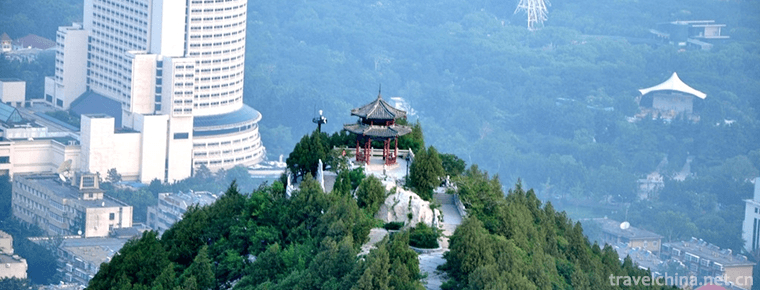
-
Twicecooked pork slices
Twice cooked pork is a traditional dish of Sichuan.
Views: 194 Time 2018-10-12 -
Cantonese crispy fried pork
Crispy fried pork is a traditional dish with color, aroma and taste. It belongs to Guangdong cuisine department. This dish is one of the classic Cantonese cured wax.
Views: 200 Time 2018-11-02 -
Funiu Mountain Skiing Resort
Located on the north slope of the old boundary ridge of Funiu Mountain in Luanchuan County, Luoyang Funiu Mountain Skiing Resort has the highest elevation of 2200 meters and an elevation of 1700 meter.
Views: 132 Time 2018-12-22 -
Shuangrufeng Scenic Area
Guizhou Shuangrufeng Scenic Area is located in Zhenfeng County, Guizhou Province. It is 9 kilometers away from the county town and on the main road of Zhenfeng-Guiyang.
Views: 164 Time 2019-02-08 -
Bouyei Leyou
Le You and Le Lang are Buyi oboe gas song instruments. They resemble suona, bowl-less, insect whistle playing, bright and sweet timbre. It can be used for Solo or singing accompaniment.
Views: 165 Time 2019-04-04 -
Firing Techniques of Liling Unglazed Colorful Porcelain
The firing technology of Liling Unglazed Five-color Porcelain, the local traditional firing technology of Liling Unglazed Five-color Porcelain in Hunan Province, is one of the national intangible cult.
Views: 165 Time 2019-05-13 -
Qingxu Caimen Building
Qingxu Caimen Tower is a local traditional handicraft in Qingxu County, Shanxi Province. Xu Caimen Tower in Qing Dynasty is said to have originated in Tang Dynasty. During the festival, people gathere.
Views: 144 Time 2019-06-11 -
Reba Dance
Reba dance is a form of dance performed by Tibetan "Reba" artists. Reba is a group of street artists who make a living selling arts (usually composed of family as the basic unit) performing,.
Views: 174 Time 2019-06-11 -
Chengdu Normal University
Chengdu Teachers College is an undergraduate teacher's college in Sichuan Province, which is a pilot University for the overall transformation of Sichuan's comprehensive reform. The school's predecess.
Views: 319 Time 2019-08-31 -
Wawu mountain
Wawu Mountain National Forest Park is under the administration of Hongya County, Meishan City, along the western edge of Sichuan Basin. It is 180 km away from Chengdu and covers an area of 1.05 million mu. .
Views: 291 Time 2020-10-15 -
History of Leshan
Leshan used to be the capital of Kaiming tribe in ancient Shu state. In 309 B.C., King Wu of Qin sent troops to the south to wipe out the rule of the Kaiming family. The state of Qin established Nan'an County in Shizhong District of Leshan City.
Views: 133 Time 2020-12-17

